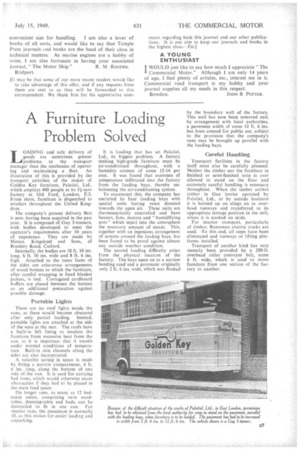A Furniture Loading Problem Solved
Page 17

If you've noticed an error in this article please click here to report it so we can fix it.
I40ADING and safe delivery of goods are sometimes greater problems to the transport manager than the mechanics of operating and maintaining a fleet. An illustration of this is provided by the transport activities of the maker of Golden Key furniture, Palatial, Ltd., which employs 400 people at its 51-acre factory at Old Ford, London, E.3. From there, furniture is dispatched to retailers throughout the United Kingdom.
[he company's present delivery fleet is new, having been acquired in the past year. It is composed of Guy 3-tonners, with bodies developed to meet the operator's requirements after 50 years of experience. They are made by Messrs. Kingsland and Sons, of Bromley Road, Catford.
Internally, the bodies are 18 ft. 10 ins. long, 6 ft. 10 ins, wide and 8 ft. 6 ins. high. Attached to the inner faces of the sides are criss-cross arrangements of wood battens to which the furniture, after careful wrapping in lined blanket jackets, is tied. Corrugated cardboard buffers are placed between the battens as an additional precaution against possible damage.
Portable Lights There are no roof lights inside the vans, as these would become obscured after only partial loading. Instead, portable lights are attached at the side of the vans at the rear. The roofs have a built-in felt lining to insulate the furniture from excessive heat from the sun, as it is important that it travels tinder normal conditions of temperature. Built-in rain channels along the sides are also incorporated.
A valuable saving in space is made by fitting a narrow compartment. 6 ft. 6 ins, long, along the bottom of on.: side of the van. It is used for carrying bed irons, which would otherwise cause obstruction if they had to be placed in
the main load space. .
On longer runs, as many as 12 bedroom suites, comprising twin wardrobes, dressing-table and beds, can be dovetailed to fit in one .van. For shorter runs, the maximum is normally 10, as this makes for easier loading and unpacking. It is. loading that has set Palatial, Ltd., its biggest problem. A factory making high-grade furniture must be air-conditioned throughout, with a humidity content of some 12-14 per cent. It was found that extremes of temperature infiltrated into the factory from the loading bays, thereby unbalancing the air-conditioning system.
To counteract this, the company has encircled its four loading bays with special units having vents directed towards the open air. These units are thermostatically controlled and have heaters, fans, motors and "humidifying pots" which inject into the atmosphere the accessary amount of steam. This, together with an ingenious arrangement of screens around the loading bays, has been found to be proof against almost any outside weather condition.
The second loading difficulty arises from the physical location of the factory. The bays open on to a narrow bending road and a pavement originally only 2 ft. 6 ins, wide, which was flanked by the boundary wall of the factory. This wall has now been removed and, by arrangement with local authorities, a pavement width of some 12 ft. 6 ins. has been created for public use, subject to the provision that the company's vans may be brought up parallel with the loading bays.
Careful Handling Transport facilities in the factory itself must also be carefully planned. Neither the timber nor the furniture in finished or semi-finished state is ever allowed to stand on the floor arid extremely careful handling is necessary throughout. When the timber arrives (either in Guy lorries operated by Palatial, Ltd., or by outside hauliers) it is hoisted up on slings on to overhead runways and transferred to its appropriate storage position in the mill, where it is stacked on skids.
For interior transport, particularly of timber, Ransomes electric trucks are used. -To this end, all steps have been eliminated and runways or lifting platforms installed.
Transport of another kind has very recently been provided by a 200-ft.
overhead roller conveyor belt, some 6 ft. wide, which is used to move furniture' from one section of the factory to another.


























